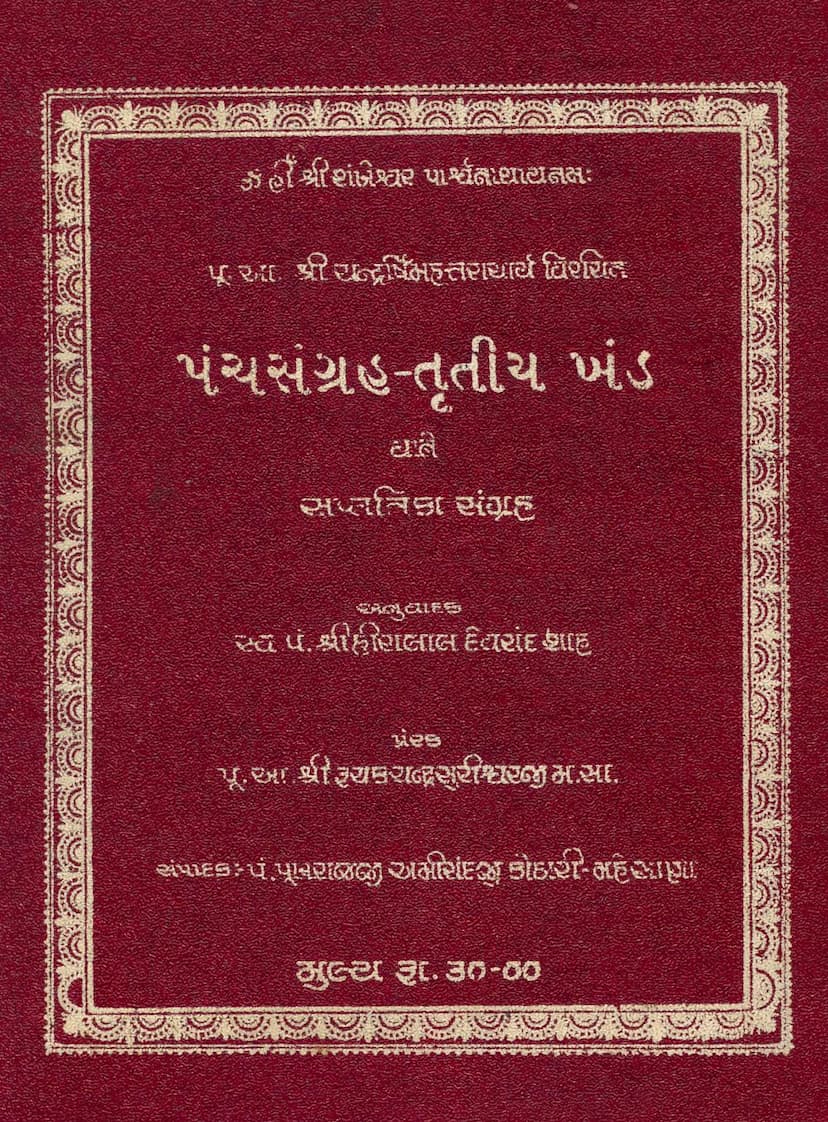Panchsangraha Part 03
Added to library: September 2, 2025

Summary
This Jain text, "Panchsangraha Part 03" by Hiralal Devchand and Pukhraj Amichand Kothari, is the third volume of a larger work on Jain philosophy and practice. It is published by Yashovijayji Jain Sanskrit Pathshala in Mahesana.
Here's a comprehensive summary based on the provided pages:
Title and Authorship:
- Book Title: Panchsangraha Part 03 (પંચસંગ્રહ-તૃતીયખંડ)
- Author(s): Hiralal Devchand (હીરાલાલ દેવચંદ) and Pukhraj Amichand Kothari (પૂખરાજ અમીચંદ કોઠારી)
- Publisher: Yashovijayji Jain Sanskrit Pathshala, Mahesana (શ્રી યશોવિજયજી જૈન સંસ્કૃત પાઠશાળા, મહેસાણા)
- Original Work: Written by Acharya Chandramahattaracharya (પૂ. શ્રી ચંદ્રર્ષિ મહત્તરાચાર્ય વિરચિત)
- Commentary: Based on the commentary by Acharya Malayagiri (પૂ. આ. શ્રી મલયગિરિ મહારાજા રચિત ટીકાનુવાદ)
- Additional Content: Includes "Saptatika Saar Sangrah" (સપ્તતિકા સાર સંગ્રહ), "Saptatika Prasnottari" (સપ્તતિકાસંગ્રહ પ્રશ્નોત્તરી), and an appendix on "Pradeshbandh" (પરિશિષ્ટ–૧ પ્રદેશબંધનું અલ્પબહુત્વ).
Core Content and Structure:
The book is the third part of the "Panchsangraha," focusing on the "Saptatika Sangraha" (Collection of Seventy [Topics/Verses]). The primary aim of this section is to elaborate on the intricate details of Jain karma theory, specifically concerning the "Bhang-Jal" (ભંગ-જાળ) – the complex interrelationships and permutations of karmic bondage, manifestation (udaya), and persistence (satta).
The text delves deeply into the "Samvedh" (સંવેધ), which refers to the complex correlations and conditions under which different karmas are bound, manifested, or persist in different spiritual stages (Gunasthanas) and life forms (Gati).
Key Concepts and Topics Covered:
-
Karma Theory (Karmakanda): The book meticulously analyzes the eight types of karma and their sub-categories, focusing on:
- Bandh (બંધ): The process of karmic bondage, including which karmas are bound together, the number of karmas bound at different stages, and the duration of their bondage.
- Udaya (ઉદય): The manifestation or fruition of karmas, how they occur in conjunction with other karmas, and their intensity.
- Satta (સત્તા): The persistence or latent state of karmas, which karmas remain in the soul's disposition, and how they are affected by different spiritual stages.
-
Samvedh (સંવેધ): This is a central theme, explaining the intricate relationships between the bondage, manifestation, and persistence of various karmas. It covers:
- How the bondage of one karma affects the manifestation or persistence of others.
- How the manifestation of one karma influences the bondage or persistence of others.
- The complex interplay between bondage, manifestation, and persistence in relation to each other.
-
Gunasthanas (ગુણસ્થાનક): The text extensively analyzes how karma functions across the 14 stages of spiritual development, from the lowest (Mithyatva) to the highest (Sanyogkevali and Ayogikevali). It details which karmas are bound, manifested, or in a state of persistence at each stage.
-
Gatis (ગતિ): The book examines how karmic processes differ for beings in the four states of existence: hellish beings (Naraka), animals (Tiryancha), human beings (Manushya), and celestial beings (Deva).
-
Prakriti (પ્રકૃતિ): The text discusses the specific nature of various karmic manifestations and bondages, particularly in relation to mohaniya karma (मोहनीयकर्म), which relates to passions and delusions.
-
Bhangas and Padavrindas (ભંગ અને પદ્મવૃંદ): A significant portion of the book is dedicated to enumerating the countless permutations and combinations (bhangas) and the total number of manifestations (padavrindas) of karmas across different spiritual stages and life forms. These are presented in a highly technical and analytical manner.
-
Specific Karmas Analyzed: While the entire spectrum of karma is discussed, a significant focus is placed on:
- Mohaniya Karma (મોહનીય કર્મ): The karma related to passions, delusions, and attachment, which is analyzed in great detail concerning its bondage, manifestation, and persistence across various Gunasthanas and Lésyas (types of karmic aura).
- Namkarma (નામ કર્મ): The karma related to the characteristics of the body and life form, its various types, bondage, manifestation, and persistence are also extensively discussed, especially in relation to different Gunasthanas and Gatis.
- Ayushkarma (આયુષ્ય કર્મ): Discussed in the context of its bondage, manifestation, and persistence across Gunasthanas and Gatis.
- Darshanavarniya Karma (દર્શનાવરણીય કર્મ): Analyzed in relation to its stages of bondage, manifestation, and persistence.
- Vedaniya Karma (વેદનીય કર્મ): Discussed regarding its bondage, manifestation, and persistence.
- Gotra Karma (ગોત્ર કર્મ): Analyzed in relation to its bondage, manifestation, and persistence.
- Jnanavarniya & Antaraya Karma (જ્ઞાનાવરણીય અને અંતરાય કર્મ): Briefly mentioned in terms of their stages of bondage, manifestation, and persistence.
Methodology and Presentation:
The text employs a rigorous, scholastic approach, likely derived from ancient Jain commentaries and the tradition of "Pramana" (પ્રમાણ) and "Naya" (નય). It uses a vast number of technical terms related to Jain philosophy and metaphysics. The detailed enumeration of "bhangas" and "padavrindas" suggests a highly systematic and analytical approach, aiming for exhaustive classification of karmic phenomena. The inclusion of verses and their detailed commentaries by Acharya Malayagiri and the Gujarati translation/explanation by Pandit Hiralal Devchand make the complex subject matter accessible (within the scope of the scholastic tradition).
Significance:
This volume is a crucial resource for serious Jain scholars and practitioners seeking to understand the profound intricacies of karma, a cornerstone of Jain philosophy. It provides a detailed map of how karmic forces operate throughout the soul's journey, offering insights into the mechanisms of liberation (Moksha). The book's focus on "Samvedh" highlights the interconnectedness of different karmic actions and their consequences across various stages of existence.
In summary, "Panchsangraha Part 03" is a highly technical and comprehensive Jain scriptural text that meticulously details the intricate workings of karma across all spiritual stages and states of existence, with a particular emphasis on the complex interrelationships of bondage, manifestation, and persistence, as elucidated by ancient Jain Acharyas.